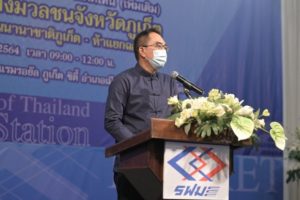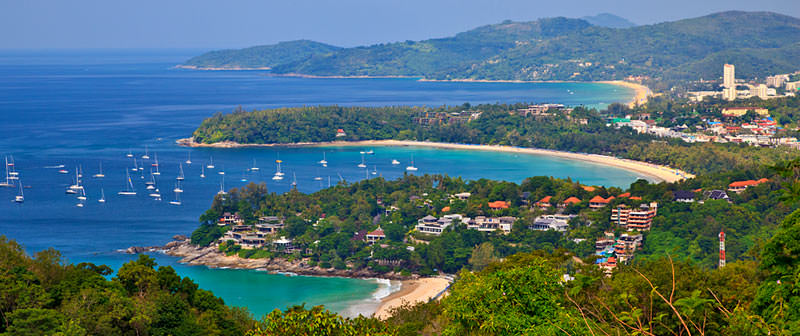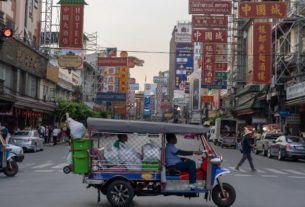
MRTA moves forward with Phuket light rail
PHUKET: The Mass Rapid Transport Authority (MRTA) kept the ‘Phuket Mass Transit System’ project moving forward with a public meeting held in Phuket Town yesterday (Nov 12) to gain feedback from local residents about the project.
The project, also often called the Phuket Light Rail, will see a light-rail mass transit system connecting Tha Noon, just north of Phuket in Phang Nga, with Phuket International Airport and continuing down the island to Phuket Town and terminating at Chalong Circle in the south of the island.
The plan is to alleviate traffic along Thepkrasattri Rd, Phuket’s main transport artery running north-south through down the “spine” of the island.
Present to open the proceedings yesterday, held at the Royal Phuket City Hotel, was Phuket Vice Governor Piyapong Choowong.
Saroj T. Suwan, MRTA Assistant Governor explained that the aim of the meeting was to publicize the project and to listen to opinions and suggestions from local people about Phase 1 of the project, from Phuket airport to Chalong Circle.
At the event the MRTA presented information on two main alternatives under consideration for the project.
The first was the “Steel Wheel Tram” and rubber wheel drive system, also often called a “rubber-tyred tram”, common in many Western countries.
The other was the Autonomous Rail Rapid Transit (ART), a LiDAR-guided articulated bus system for urban passenger transport developed by CRRC Zhuzhou Institute Co Ltd, unveiled in Zhuzhou in Hunan province in 2017.
 The other aspect explained at the meeting was that the mass transit system is part of an integrated plan being developed alongside the Kathu – Patong Expressway Construction Project, being developed by the Expressway Authority of Thailand (EXAT). The expressway will run parallel to the Thepkrasattri Rd, with EXAT expecting to open the expressway in 2026.
The other aspect explained at the meeting was that the mass transit system is part of an integrated plan being developed alongside the Kathu – Patong Expressway Construction Project, being developed by the Expressway Authority of Thailand (EXAT). The expressway will run parallel to the Thepkrasattri Rd, with EXAT expecting to open the expressway in 2026.
“Such joint efforts will be able to mitigate the impact on traffic on National Highway No. 402 [Thepkrasattri Rd] during the construction of the project and on the people in the area,” Mr Sarot said.
“At the same time, Phuket residents and groups of stakeholders in the area are allowed to participate in expressing opinions and suggestions on the alternatives. In implementing the project, the MRTA will use the information received from this meeting to be used as a guideline for further improvement of project operations,” he said.
Of note, all large-scale public infrastructure development projects by law must conduct public feedback meetings in order to legally fulfill Environmental Impact Assessment (EIA) requirements.
“When the project is completed, it will increase the efficiency and standardized travel options ready to support travel and tourism of Phuket in the future,” Mr Sarot said.
People were invited to seek more information about the project through the MRTA website (www.mrta.co.th) or its Facebook page, or call the MRTA headquarters in Bangkok at 02-716 4044.
According to the current plans, the “railway system” will be Light Rail Transit (low floor TRAM) with carriages 2.4-2.65 metres wide and 30-40m long overall.
There will be 21 stations along the route, with the system elevated from Phuket International Airport as it parallels Highway No. 4031, but returning to ground level where it joins Thepkrasattri Rd. The “Thalang Station” will be underground.
The current plans also include changes to one way streets through the heart of Phuket Town and the size and location of parking centres for people using the transit system, including a car park for 200 cars and 500 motorcycles to be built at the terminus near Chalong Circle.
Transport Minister Saksayam Chidchob earlier this year ordered an in-depth analysis of a proposal to dump the Phuket light-rail project in favour of a ‘smart bus’ system that would reduce the cost of launching a mass transport option on the island by some B15.2 billion.
Phase 1 of the project, from Phuket airport to Chalong Circle, is budgeted to cost more than B35 billion.
The cost of Phase 2 of the project, connecting Phase 1 with Tha Noon in Phang Nga, has yet to be estimated.
In Phuket for a public feedback meeting held at the Royal Phuket City hotel last year, Mr Sarot explained that construction of the Phuket light-rail project is now expected to begin in 2023 and open to serve passengers in 2026.
Source: https://www.thephuketnews.com/mrta-moves-forward-with-phuket-light-rail-82015.php



